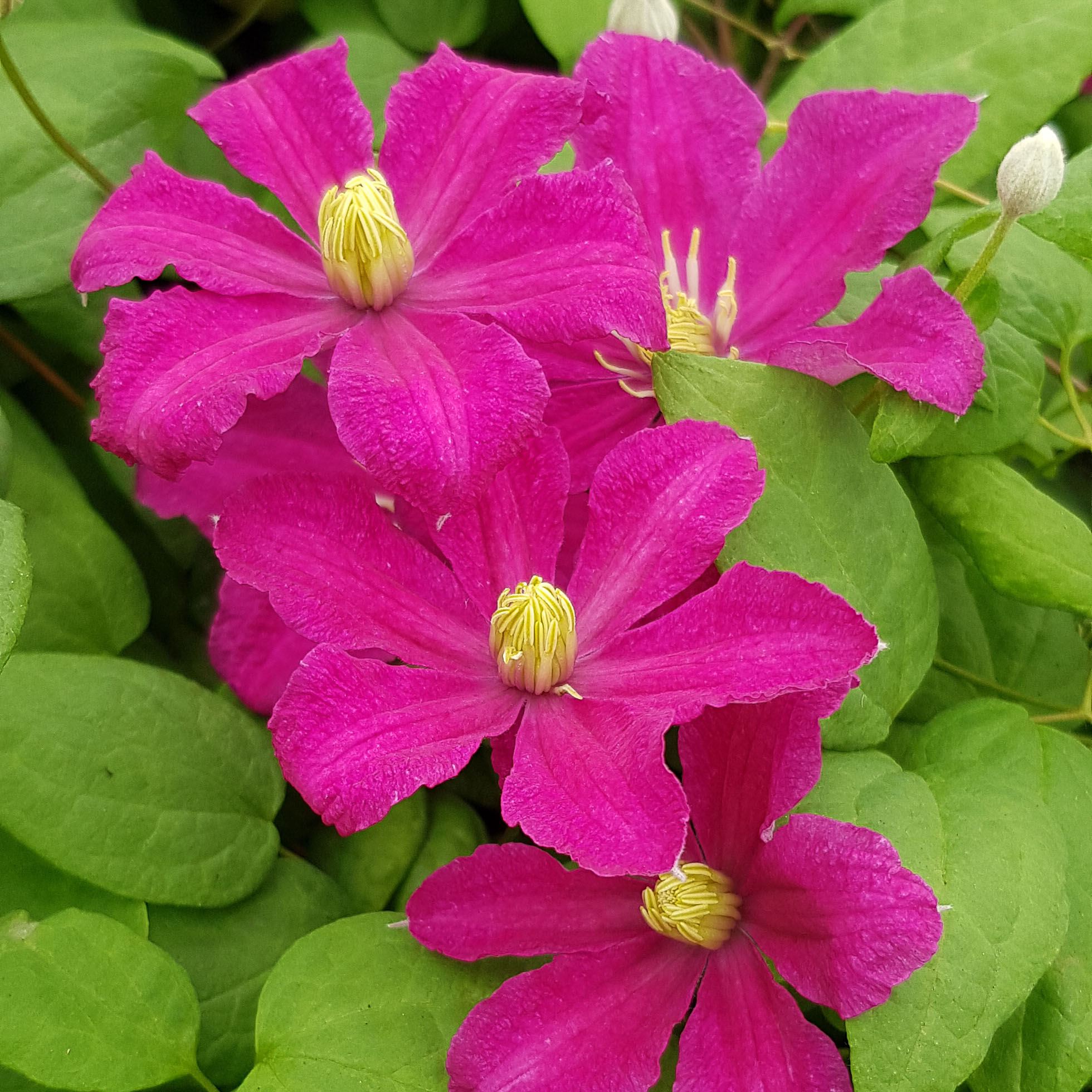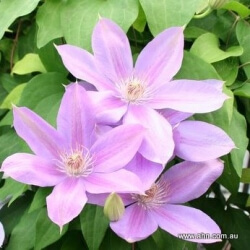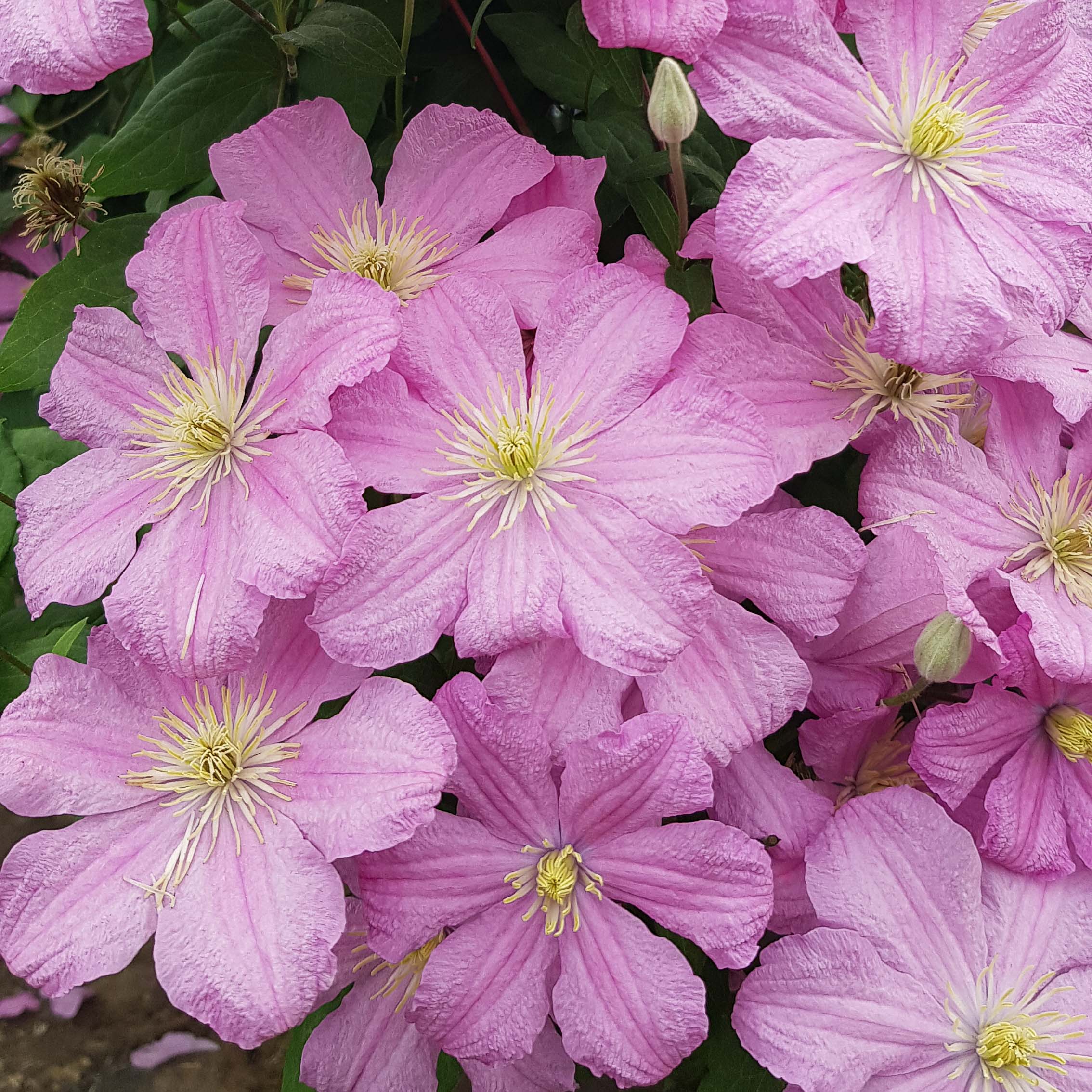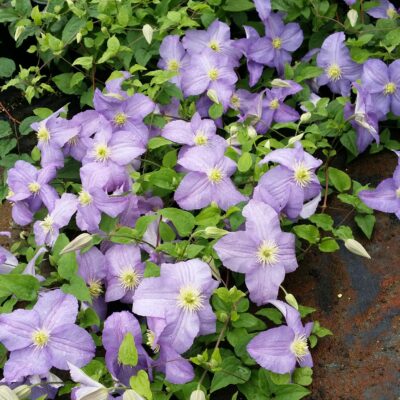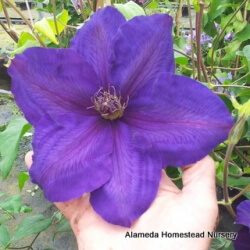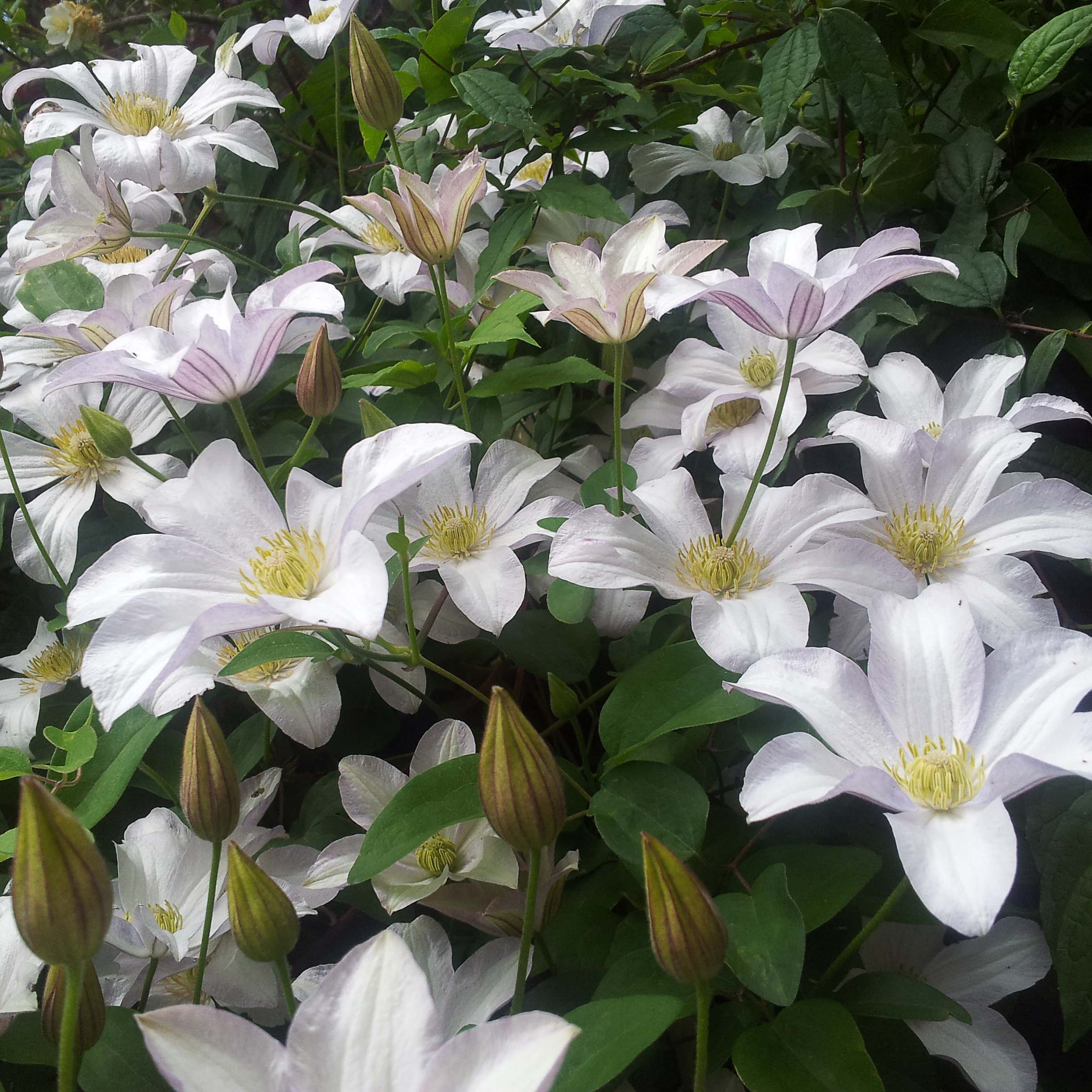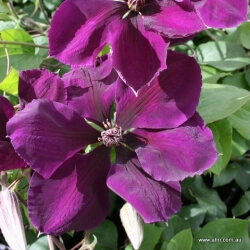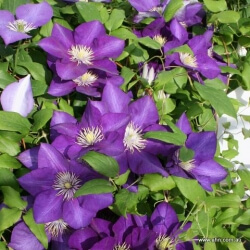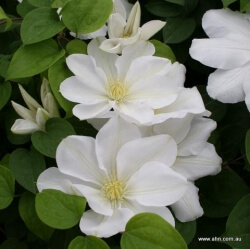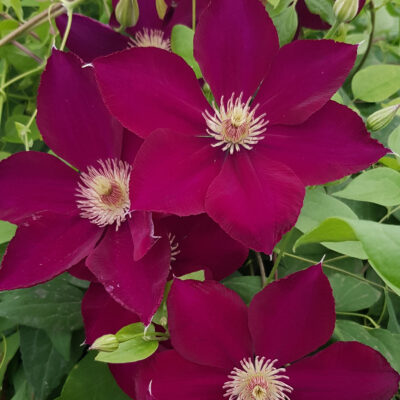Growth ultimately depends on the position, water, soil, fertilizer and sunlight so this is only a guide.
-
Out of stock
 Clematis 'Bieszczady' is a captivating deciduous climber developed by Polish breeder Szczepan Marczyński and introduced to Australia by Alameda Homestead Nursery in 2025. This variety is celebrated for its large, vibrant pink flowers, measuring 14–20 cm in diameter. Each is adorned with a nearly white central bar and claret anthers on pink filaments. Blooming profusely from late spring to early autumn, it offers a long-lasting display of colour throughout the summer months. Reaching 2 to 3 meters, 'Bieszczady' climbs by twining its leaf petioles around supports, making it ideal for trellises, fences, pergolas, and other garden structures. It thrives in well-drained, fertile soils with a neutral to slightly acidic ph and prefers locations with good light exposure. As a member of pruning group 3, 'Bieszczady' requires hard pruning in early spring to encourage vigorous new growth and abundant flowering. Its striking blooms and robust growth habit make it a standout choice for gardeners seeking to add vertical interest and vibrant colour to their landscapes.
Clematis 'Bieszczady' is a captivating deciduous climber developed by Polish breeder Szczepan Marczyński and introduced to Australia by Alameda Homestead Nursery in 2025. This variety is celebrated for its large, vibrant pink flowers, measuring 14–20 cm in diameter. Each is adorned with a nearly white central bar and claret anthers on pink filaments. Blooming profusely from late spring to early autumn, it offers a long-lasting display of colour throughout the summer months. Reaching 2 to 3 meters, 'Bieszczady' climbs by twining its leaf petioles around supports, making it ideal for trellises, fences, pergolas, and other garden structures. It thrives in well-drained, fertile soils with a neutral to slightly acidic ph and prefers locations with good light exposure. As a member of pruning group 3, 'Bieszczady' requires hard pruning in early spring to encourage vigorous new growth and abundant flowering. Its striking blooms and robust growth habit make it a standout choice for gardeners seeking to add vertical interest and vibrant colour to their landscapes. -
Out of stock
 Clematis 'Heavenly Blue' is a striking deciduous climber known for its large, deep purplish-blue flowers adorned with creamy yellow anthers. Each bloom measures approximately 12–17 cm in diameter and features 6 to 8 overlapping tepals, creating a lush, full appearance. This cultivar, bred by P. Sorensen in New Zealand around 2002 and introduced in 2007, is a hybrid of 'Lasurstern' crossed with an unknown parent. It typically reaches a height of 2.5 to 3 meters, making it ideal for trellises, fences, or pergolas. 'Heavenly Blue' thrives in well-drained soil and benefits from full sun to partial shade. Its vibrant blooms and vigorous growth habit make it a standout choice for gardeners seeking to add vertical interest and a splash of colour to their landscapes.
Clematis 'Heavenly Blue' is a striking deciduous climber known for its large, deep purplish-blue flowers adorned with creamy yellow anthers. Each bloom measures approximately 12–17 cm in diameter and features 6 to 8 overlapping tepals, creating a lush, full appearance. This cultivar, bred by P. Sorensen in New Zealand around 2002 and introduced in 2007, is a hybrid of 'Lasurstern' crossed with an unknown parent. It typically reaches a height of 2.5 to 3 meters, making it ideal for trellises, fences, or pergolas. 'Heavenly Blue' thrives in well-drained soil and benefits from full sun to partial shade. Its vibrant blooms and vigorous growth habit make it a standout choice for gardeners seeking to add vertical interest and a splash of colour to their landscapes. -
 Clematis 'Blue Explosion' is a striking deciduous climber developed by Polish breeder Szczepan Marczyński in 1995. Renowned for its vibrant blooms, this variety produces large, single flowers on old wood in late spring to early summer, followed by single blooms on new growth from midsummer to early autumn. The blossoms, measuring up to 15 cm in diameter, feature a captivating blend of blue petals with pink-flushed tips and yellow anthers, creating a dynamic. Reaching heights of 2.5 to 3 meters, 'Blue Explosion' thrives in full sun to partial shade. While the vine prefers its foliage in sunlight, keeping the roots cool and shaded is essential—mulching or planting low-growing perennials nearby can help achieve this. It grows best in moist, well-drained soils with a neutral to slightly alkaline. This clematis belongs to pruning group 2 and requires light pruning after the first flowering to encourage new blooms. Its long blooming period and vibrant colours make 'Blue Explosion' an excellent choice for trellises, fences, or pergolas, adding vertical interest and attracting pollinators to the garden.
Clematis 'Blue Explosion' is a striking deciduous climber developed by Polish breeder Szczepan Marczyński in 1995. Renowned for its vibrant blooms, this variety produces large, single flowers on old wood in late spring to early summer, followed by single blooms on new growth from midsummer to early autumn. The blossoms, measuring up to 15 cm in diameter, feature a captivating blend of blue petals with pink-flushed tips and yellow anthers, creating a dynamic. Reaching heights of 2.5 to 3 meters, 'Blue Explosion' thrives in full sun to partial shade. While the vine prefers its foliage in sunlight, keeping the roots cool and shaded is essential—mulching or planting low-growing perennials nearby can help achieve this. It grows best in moist, well-drained soils with a neutral to slightly alkaline. This clematis belongs to pruning group 2 and requires light pruning after the first flowering to encourage new blooms. Its long blooming period and vibrant colours make 'Blue Explosion' an excellent choice for trellises, fences, or pergolas, adding vertical interest and attracting pollinators to the garden. -
 A vigorous decidous climber producing large, bright crimson red flowers, pinkish-grey on the outside. Dark brown anthers on pale violet filaments. Growth to 3 mt. Pruning group 3 (hard Prune).This variety is deciduous and a climber. Named after Cardinal Stefan Wyszynski (1901-1981). He was a great and just man whose life was an example to others.
A vigorous decidous climber producing large, bright crimson red flowers, pinkish-grey on the outside. Dark brown anthers on pale violet filaments. Growth to 3 mt. Pruning group 3 (hard Prune).This variety is deciduous and a climber. Named after Cardinal Stefan Wyszynski (1901-1981). He was a great and just man whose life was an example to others. -
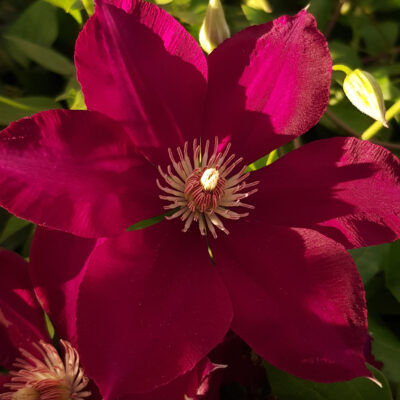 Medium velvety dark violet-purple flowers 10-12cm with a slightly paler bar produced on a strong vine growing 2.5-3.0mt. Flowering starts in late spring and goes into early autumn. Deciduous and a climber. Pruning group 3. The name commemorates the village in north-east Poland where, on 15 July 1410, during one of the largest Medieval European battles, the Polish-Lithuanian military forces decisively defeated the German-Prussian Teutonic knights.
Medium velvety dark violet-purple flowers 10-12cm with a slightly paler bar produced on a strong vine growing 2.5-3.0mt. Flowering starts in late spring and goes into early autumn. Deciduous and a climber. Pruning group 3. The name commemorates the village in north-east Poland where, on 15 July 1410, during one of the largest Medieval European battles, the Polish-Lithuanian military forces decisively defeated the German-Prussian Teutonic knights. -
 Another fantastic Clematis from Polish Breeder Szczepan Marczyński. The flowers are dense pink-violet veins over a white background, but paler along the bar and creamy white towards the base. Flowering is from late spring to autumn; the plant grows 2.5- 3.0 m. This variety is deciduous and in pruning group 3.
Another fantastic Clematis from Polish Breeder Szczepan Marczyński. The flowers are dense pink-violet veins over a white background, but paler along the bar and creamy white towards the base. Flowering is from late spring to autumn; the plant grows 2.5- 3.0 m. This variety is deciduous and in pruning group 3.

